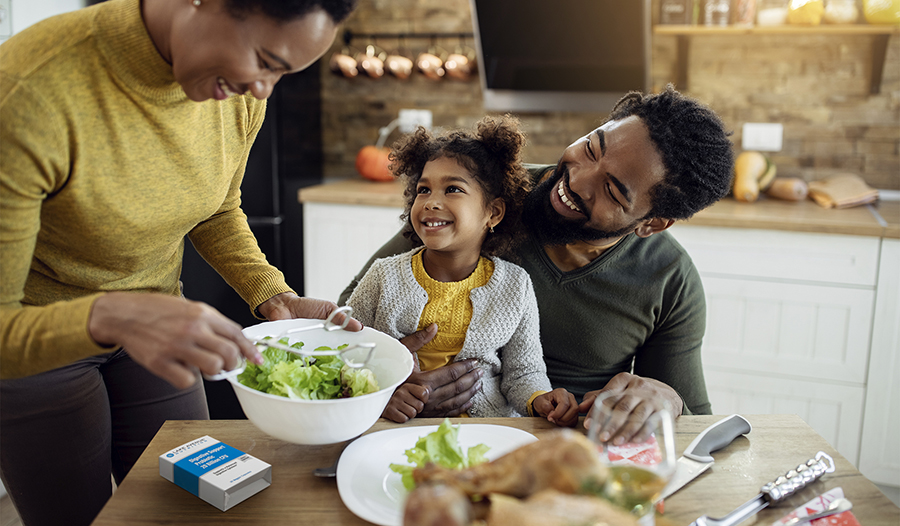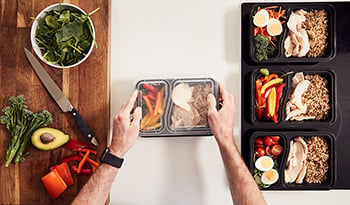How to Balance Healthy Holiday Eating According to a Dietician

Get your oven ready: holiday cooking is upon us. Fall and winter are packed with holidays and are arguably the most wonderful time of the year. Whether that’s because you get to spend time with those you love or eat your favorite holiday foods like pumpkin, cranberry, and peppermint. You may even enjoy the weather changing, or the opportunity to take time off of work and start planning and attending events.
A common concern during this time of the year is eating healthy. It is often said that the average American gains five pounds each year during the holidays but many studies have shown that to be false and the amount is actually quite less. Still, most food options that are available during the holidays aren’t typically what we would classify as nutrient-dense, but sure are tasty and come with great memories.
Eating healthy during the holidays doesn’t mean giving up your favorite dishes—it just means making a few changes and additions to your plate and lifestyle around this time of year. Instead of focusing on weight, focus on the three Fs: friends, family, and food. The holidays are a time for you to spend with the ones you love, enjoying good times and good eats. This article will show you how to be more comfortable with upcoming events and make the season as stress-free as possible.
Serving Size vs Portion Size
Serving size and portion size are some of the biggest culprits that make eating healthy difficult. In recent years, American plates have been growing and with them, portion sizes have been increasing. Serving size is the recommended amount you should eat—for example, what the label on packaged food suggests, like 1 cup of cereal.
Portion size, on the other hand, is the amount that you put on your plate. Listening to your hunger cues on how much you should eat is the best way to find what works best for you. Using a smaller plate and utensils may also be advisable. The larger the plate, the more food will go on it.
10 Healthy Holiday Eating Tips
When you’re looking to make changes to your health, start small and build upon each goal. If you know you have trouble adding vegetables to your plate at meals or if you know you love holiday drinks, make your first goal one of those things you know you struggle most with. Once you’ve mastered your first goal, feel free to add more and keep that pattern going until you’re satisfied with your progress.
Here are some holiday eating tips that you can put into practice without sacrificing the foods you love.
1. Scan and Evaluate the Options
Most holiday events have endless food selections, before putting anything on your plate scan the options first to see what catches your eye. Only pick out those options that you really want. Limit going back for seconds unless you are still hungry. If you want a little more of something, take it to go.
2. Add Fruit and Vegetables to Your Plate First
Fruits and vegetables should make up half of your plate. This is because they have high nutrient content and help create a balanced plate, especially when adding more fun foods.
3. Don’t Skip Meals
Even though you may be planning a larger meal at some point, it’s important to not skip meals. Skipping meals leads to feelings of extreme hunger which then leads to feelings of extreme fullness. An easy way to remember is skipping → starving → stuffed.
4. Slow Down During Meal Times
Many studies have shown that eating slower during meals allows our stomach to send fullness signals to avoid overeating. We all know the infamous after-Thanksgiving-dinner fullness. This tip is a great way to avoid needing to take a nap or unbutton your pants.
5. Listen to Your Hunger Cues
Only eat until you feel satisfied. Using a hunger scale of 1-10 can help you determine how full you are. Use 1 as very hungry—your stomach is grumbling and you need to eat. 10 indicates that you are beyond full and feel uncomfortable. Ideally, you will want to be between a 5-7 on the hunger fullness scale after meals.
6. Try Not to Shop While Hungry
Some studies have shown that shopping while hungry may lead to purchasing foods that you didn’t plan to buy before leaving. If you’re doing holiday food shopping, have a snack or meal before you go.
7. Don’t Forget Physical Activity
Research has shown that doing some type of physical activity after meals helps stimulate your pancreas to make more insulin and promote digestion. Ideas for activities can include walking or playing games outside with friends and family, like a friendly game of touch football.
8. Eat Before Leaving the House
If you’re unsure of options that will be available at a holiday gathering, eat something before you go. You can eat something light at home and have snacks and other offerings while there. If you are comfortable with the host, you may even be able to help plan which food options will be served.
9. Bring a Healthy Dish
This is a nice gift for the host but also ensures that you will have at least one option available that you know you like. Taking a vegetable-rich dish can help balance out your plate.
10. Support Your Gut
Despite your best efforts, you may still overindulge—you’re only human, right? Probiotic supplements and digestive enzymes can help to keep your gut in balance, even when you’re enjoying a second helping.
Again, if these tips feel overwhelming, pick your top two goals to work on and just focus on those. Nutrition is a work in progress and not all habits can be changed overnight. Keep your goal in mind and continue to work towards it. If you need additional help, you may seek out a Registered Dietitian to assist you in reaching your goals.
How to Healthify the Holiday Classics
Holiday foods are usually more decadent than typical foods eaten each day. Don’t feel like you have to give up old favorites, though. There are ways to modify recipes to make them even more nutritious, including:
- Make mashed potatoes with low-sodium vegetable broth instead of using a lot of milk and butter.
- Use yogurt instead of regular sour cream on dishes.
- Make plenty of roasted vegetables to serve as a side item.
- Avoid full-fat dairy products while cooking and use coconut milk instead.
- Use a heart-healthy oil such as olive oil in place of butter, lard, or margarine.
- Have one stunning dessert and offer fresh fruit instead of a variety of sweet treats.
- Make homemade trail mix instead of chips, candy, and other snacks.
- Choose plant-based proteins instead of meat for the main course.
- Drink alcohol in moderation.
- Try using half as much sugar as recipes call for or a natural sweetener—usually, they will still taste sweet.
Takeaway
From Halloween to New Year’s Day, you may run into some hiccups when it comes to healthy eating. Eating during the holidays may cause stress and uncertainty, but you can use the tips in this article to help make this time of the year wonderful. Remember not to drag each holiday out for weeks and instead enjoy them as they come. Practice self-care and forgiveness with yourself, too. There is no need to beat yourself up about what you eat. But no matter how you plan to spend your holidays, make sure your health is a priority.
References:
- https://www.health.harvard.edu/blog/why-eating-slowly-may-help-you-feel-full-faster-20101019605
- https://jamanetwork.com/journals/jamainternalmedicine/fullarticle/1685889
- https://www.ncbi.nlm.nih.gov/pmc/articles/PMC3119587/
DISCLAIMER:This Wellness Hub does not intend to provide diagnosis...













































































 Table of Contents
Table of Contents

















